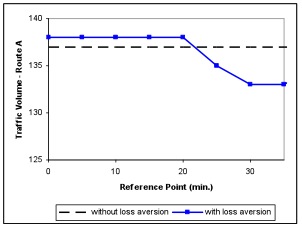Loss aversion on the road
By Erel Avineri
In congested traffic networks the travel time on each road is a function of supply and demand. The supply is represented by the capacity of the road (the maximum volume of traffic it could possibly carry), and the demand is represented by the actual traffic volume (the number of vehicles on the road). Since the travel choices made by individual users have a direct effect on the performance of the overall traffic network, understanding how drivers make choices is an area of great interest to transport practitioners involved in the planning, design and management of traffic networks.
Individual travelers are commonly treated by transport modelers as rational human beings who, through choice making, maximize their utilities. For example we assume that in order to get home from work, they will choose the routes that minimize their journey times. If each person non-cooperatively seeks to minimize her travel times it is expected that the traffic network will reach a “user equilibrium” state: A situation in which journey times in all routes actually used are equal, and no user can reduce her travel time by shifting to another route (this is known as “Wardrop’s first principle of equilibrium”).
But do travelers behave according to the “rational man” theory? Recent studies that report that when provided with information on their choices, travelers tend to interpret and value this information in a way that systematically violates the predictions of rational behavior. For example, travelers tend to behave differently when travel time associated with route choices are presented as gains or as losses. Imagine two people, A and B, who are used to have a commute time of about 20 minutes. Travelling to work today, person A experienced a 30 minutes journey time, while B’s commute time was only 10 minutes. Person A would consider his experience as a ‘loss’ while B might see herself as a ‘winner’. Winning and loosing in this context is measured against some reference point, in this example – a commute time of 20 minutes. Moreover, A will lose more satisfaction than B will gain satisfaction from a 10 minutes change. Generally, travelers’ route choices exhibit “loss aversion”, a main feature in Tversky & Kahneman’s “Prospect Theory”. Travelers’ pattern of risk attitudes revealed in their route choices can be described as risk aversion when the outcomes of alternative choices are framed as gains, and risk seeking when outcomes are framed as losses.
Incorporating loss aversion into the modeling of transport networks is illustrated by a simple route choice problem (full formulation and analysis of the problem are given in Avineri (2006)). Travel time on each route is a function of the traffic volume on the route, the route capacity, and a random component of travel time that was not related to congestion. Carrying the same traffic volume, route A would perform better than route B and on average will have the lower travel time. On the other hand, the different random time components make route A to be the “riskier” one. The route choices of 200 drivers who travel daily on this two-link network were simulated on the network, assuming all drivers exhibit loss aversion in their choice behavior, against a certain reference point. Making use of the functional forms and parameter values estimated by Tversky & Kahneman in the development of Prospect Theory, Wardrop’s principle of user equilibrium was extended to capture loss aversion.

In a “traditional” traffic equilibrium 137 of the 200 drivers choose route A, and 63 choose route B, with a travel time of 24 minutes on each route.
The predictions of a traffic equilibrium model based on loss aversion were found to be very sensitive to the value of the reference point; for reference point routes with low values, A looks more attractive for drivers than it would be for reference points with higher values, as can be seen from the following graph:

In a traditional traffic equilibrium, a driver who has a reference point of 15 will consider the journey time on either route (24 minutes) to be a loss, and therefore she will seek more risk. This makes route A, the more risky route, become more attractive for such a driver. On the other hand, for a driver who has a reference point of 30 minutes the traditional equilibrium travel times will be perceived as gains, and therefore she will tend to reduce the risks; this makes route B, the more risky route, become more attractive for such a driver.
This sensitivity of the traffic equilibrium to the value of the reference point, and the concept of loss aversion, may be relevant not only to transport modelers (who would like to improve the predictive value of their models) but also to network operators and policy makers. The latter are interested in finding ways to influence travel demand in order to improve traffic flow and reduce congestion. One common (but highly unpopular!) way to do influence travel demand is by restricting it. Economic interventions, such as road pricing, also suffer from low support from the public. The above example illustrate the potential of another, more libertarian, approach; setting a reference value to distinguish between subjective losses and gains in journey times might be used as a kind of a nudge to influence route choice and, when appropriately applied, lead to a better performance of the traffic network – without restricting drivers’ choices.
For detailed description of the traffic problem and research findings, see Avineri’s 2006 article The Effect of Reference Point on Stochastic Network Equilibrium in Transportation Science (gated copy).

March 13, 2009 at 2:44 am |
“he will tend to reduce the risks; this makes route B, the more risky route, to become more attractive for such a driver.”
Should read: “he will tend to reduce the risks; this makes route B, the LESS risky route, to become more attractive for such a driver.”